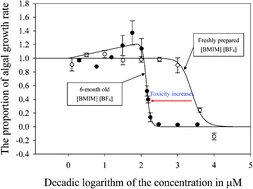Investigations on the influence of anions of ionic liquids, with respect to toxicity and ecotoxicity, have been reported; however, no consistent conclusion has been drawn. The aim of this study was to elucidate the influence of the anionic component, using the alga Selenastrum capricornutum, by assessing the toxicity of various anions associated with imidazolium-based ionic liquids as well as alkali salts. Additionally, the hydrolysis of fluoride-containing ionic liquids, i.e., 1-butyl-3-methylimidazolium [BMIM], incorporated with tetrafluoroborate, hexafluorophosphate and hexafluoroantimonate, was also estimated. The results obtained revealed that imidazolium-based ionic liquids were more toxic than their corresponding alkali salts. In both cases, SbF6– and PF6– were identified as the most toxic anions. In general, Selenastrum capricornutum was sensitive to the anion moieties in the order: SbF6– > PF6– > BF4– > CF3SO3– > C8H17OSO3– > Br– ≈ Cl–. With regard to the hydrolytic effect, [BMIM][SbF6] generated a greater amount of fluoride compared with [BMIM][BF4], but no fluoride formation occurred with the hexafluorophosphate.

You have access to this article
 Please wait while we load your content...
Something went wrong. Try again?
Please wait while we load your content...
Something went wrong. Try again?


 Please wait while we load your content...
Please wait while we load your content...